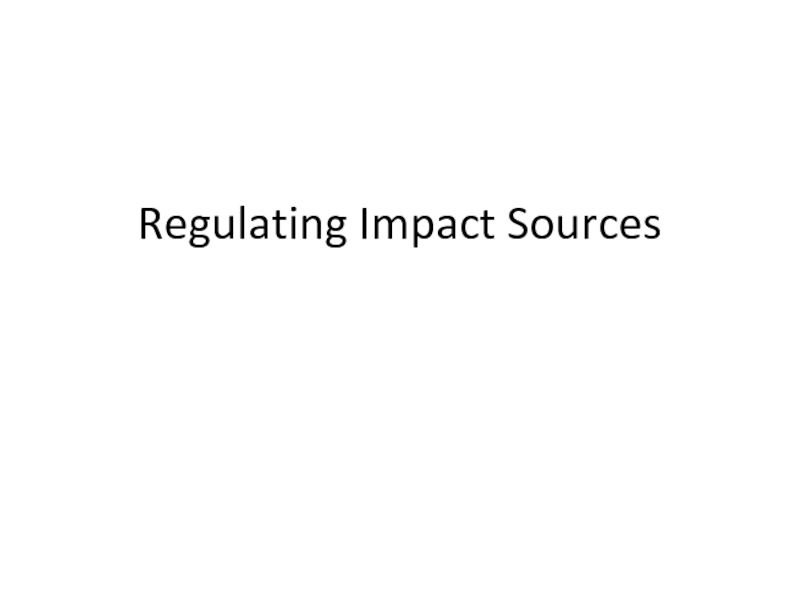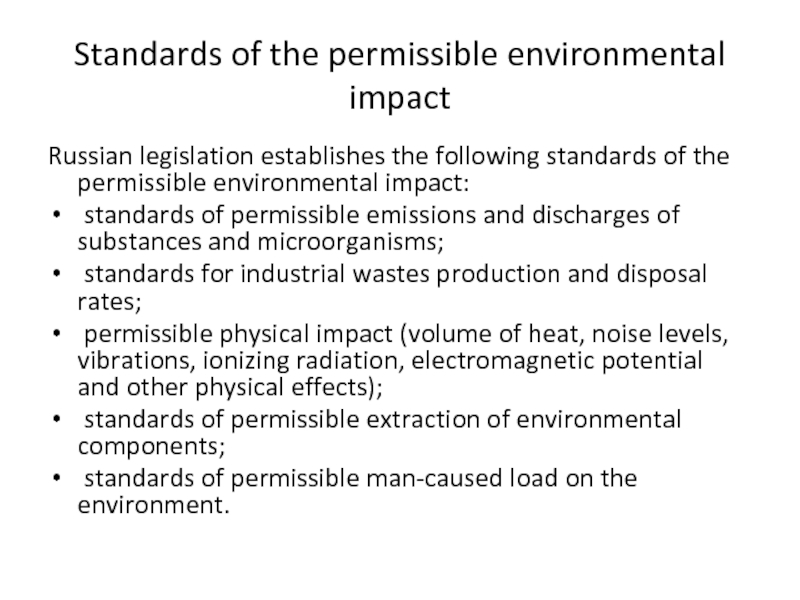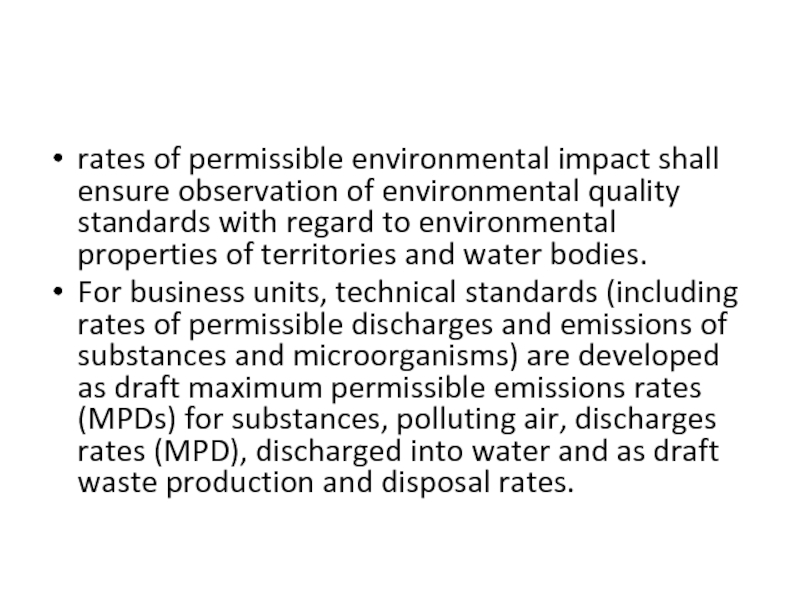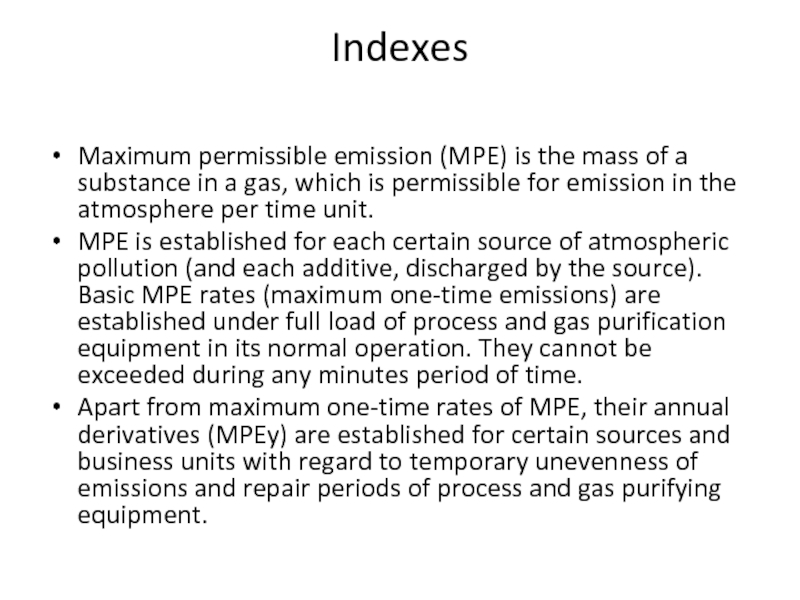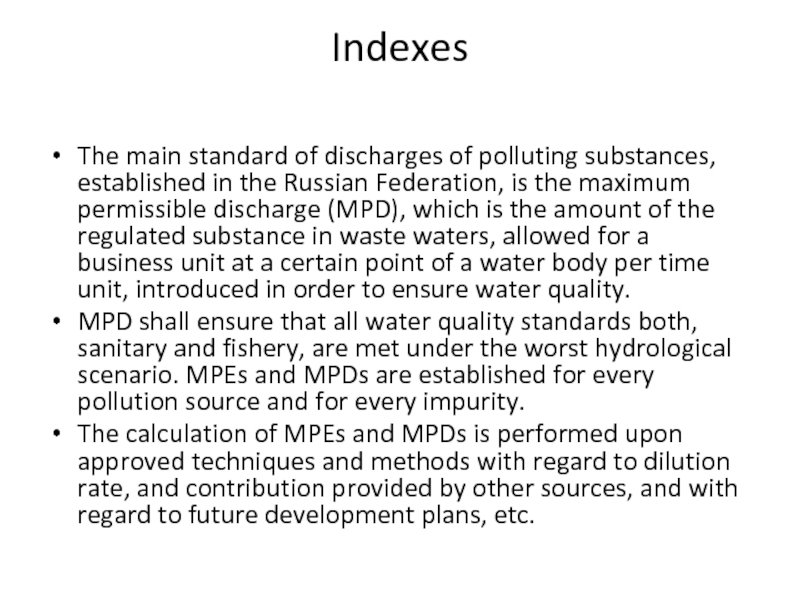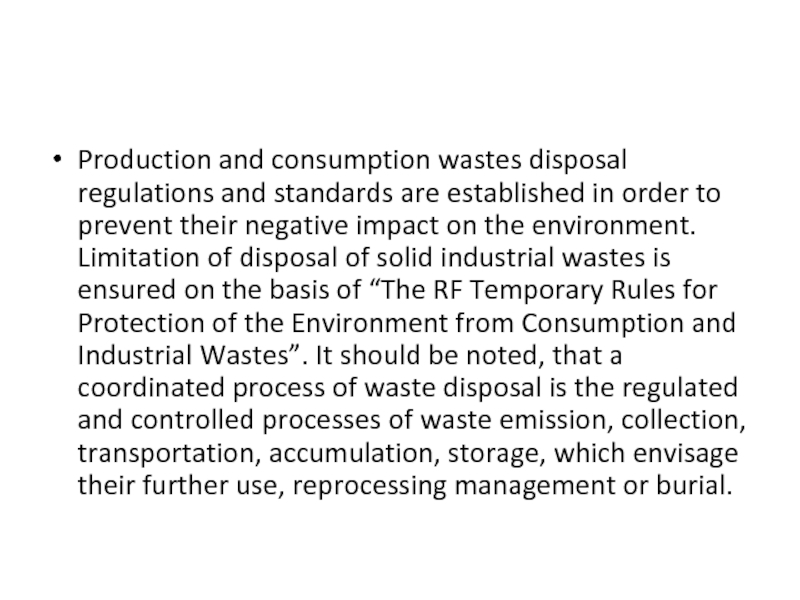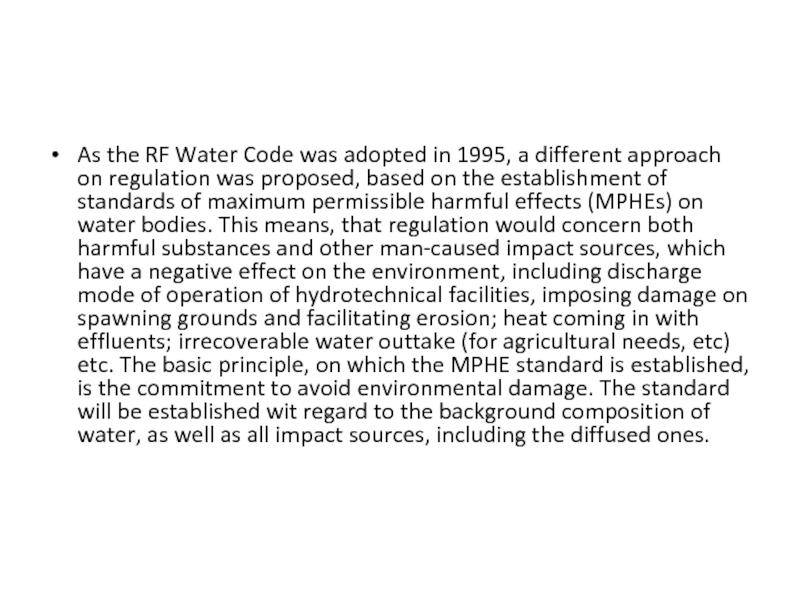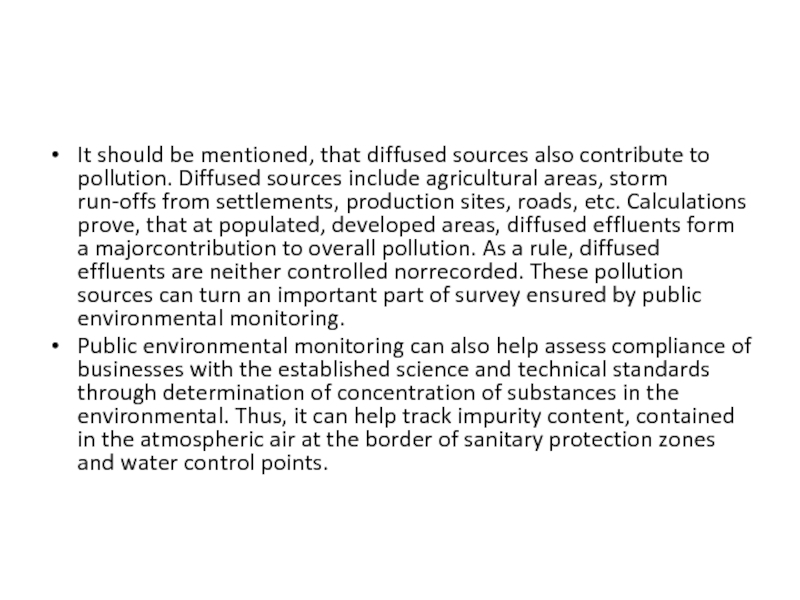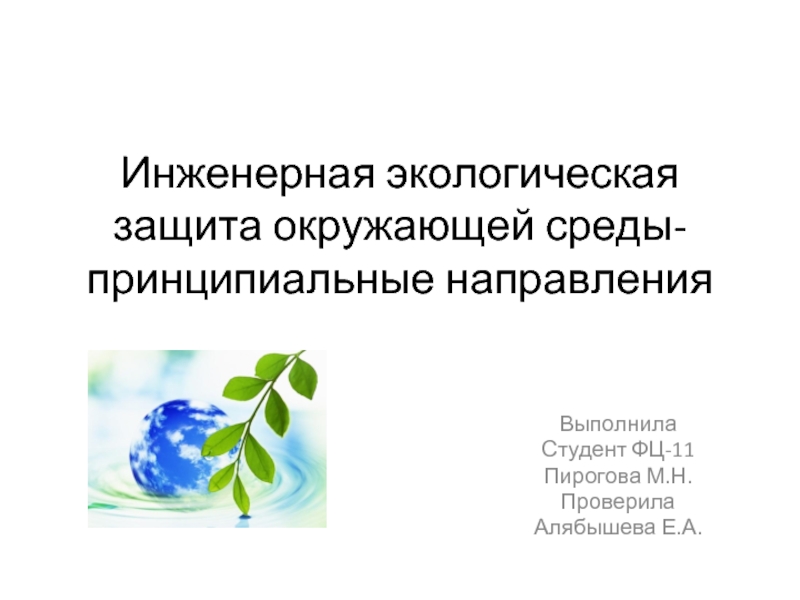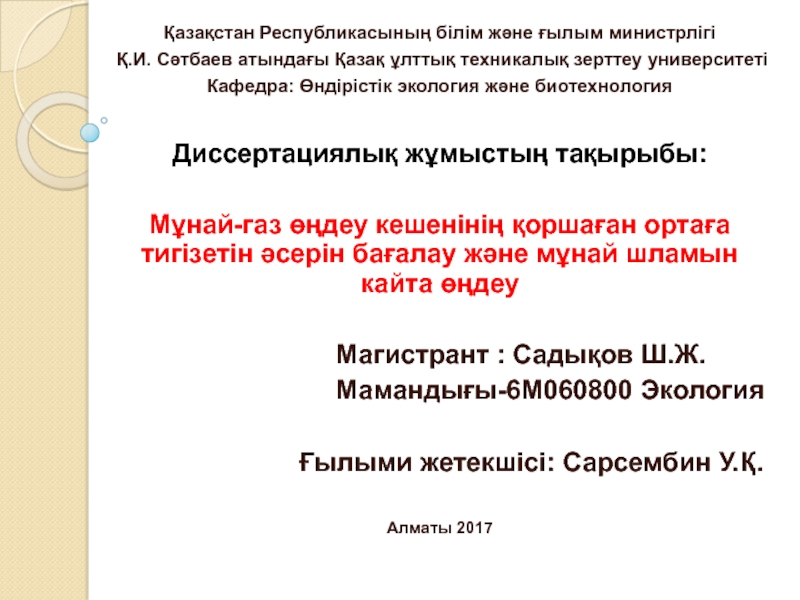- Главная
- Разное
- Дизайн
- Бизнес и предпринимательство
- Аналитика
- Образование
- Развлечения
- Красота и здоровье
- Финансы
- Государство
- Путешествия
- Спорт
- Недвижимость
- Армия
- Графика
- Культурология
- Еда и кулинария
- Лингвистика
- Английский язык
- Астрономия
- Алгебра
- Биология
- География
- Детские презентации
- Информатика
- История
- Литература
- Маркетинг
- Математика
- Медицина
- Менеджмент
- Музыка
- МХК
- Немецкий язык
- ОБЖ
- Обществознание
- Окружающий мир
- Педагогика
- Русский язык
- Технология
- Физика
- Философия
- Химия
- Шаблоны, картинки для презентаций
- Экология
- Экономика
- Юриспруденция
Regulating Impact Sources презентация
Содержание
- 1. Regulating Impact Sources
- 2. Standards of the permissible environmental impact Russian
- 3. rates of permissible environmental impact shall
- 4. Indexes Maximum permissible emission (MPE) is
- 5. Indexes The main standard of discharges
- 6. Production and consumption wastes disposal regulations
- 7. As the RF Water Code was
- 8. It should be mentioned, that diffused
Слайд 2Standards of the permissible environmental impact
Russian legislation establishes the following standards
of the permissible environmental impact:
standards of permissible emissions and discharges of substances and microorganisms;
standards for industrial wastes production and disposal rates;
permissible physical impact (volume of heat, noise levels, vibrations, ionizing radiation, electromagnetic potential and other physical effects);
standards of permissible extraction of environmental components;
standards of permissible man-caused load on the environment.
standards of permissible emissions and discharges of substances and microorganisms;
standards for industrial wastes production and disposal rates;
permissible physical impact (volume of heat, noise levels, vibrations, ionizing radiation, electromagnetic potential and other physical effects);
standards of permissible extraction of environmental components;
standards of permissible man-caused load on the environment.
Слайд 3
rates of permissible environmental impact shall ensure observation of environmental quality
standards with regard to environmental properties of territories and water bodies.
For business units, technical standards (including rates of permissible discharges and emissions of substances and microorganisms) are developed as draft maximum permissible emissions rates (MPDs) for substances, polluting air, discharges rates (MPD), discharged into water and as draft waste production and disposal rates.
For business units, technical standards (including rates of permissible discharges and emissions of substances and microorganisms) are developed as draft maximum permissible emissions rates (MPDs) for substances, polluting air, discharges rates (MPD), discharged into water and as draft waste production and disposal rates.
Слайд 4Indexes
Maximum permissible emission (MPE) is the mass of a substance in
a gas, which is permissible for emission in the atmosphere per time unit.
MPE is established for each certain source of atmospheric pollution (and each additive, discharged by the source). Basic MPE rates (maximum one-time emissions) are established under full load of process and gas purification equipment in its normal operation. They cannot be exceeded during any minutes period of time.
Apart from maximum one-time rates of MPE, their annual derivatives (MPEy) are established for certain sources and business units with regard to temporary unevenness of emissions and repair periods of process and gas purifying equipment.
MPE is established for each certain source of atmospheric pollution (and each additive, discharged by the source). Basic MPE rates (maximum one-time emissions) are established under full load of process and gas purification equipment in its normal operation. They cannot be exceeded during any minutes period of time.
Apart from maximum one-time rates of MPE, their annual derivatives (MPEy) are established for certain sources and business units with regard to temporary unevenness of emissions and repair periods of process and gas purifying equipment.
Слайд 5Indexes
The main standard of discharges of polluting substances, established in the
Russian Federation, is the maximum permissible discharge (MPD), which is the amount of the regulated substance in waste waters, allowed for a business unit at a certain point of a water body per time unit, introduced in order to ensure water quality.
MPD shall ensure that all water quality standards both, sanitary and fishery, are met under the worst hydrological scenario. MPEs and MPDs are established for every pollution source and for every impurity.
The calculation of MPEs and MPDs is performed upon approved techniques and methods with regard to dilution rate, and contribution provided by other sources, and with regard to future development plans, etc.
MPD shall ensure that all water quality standards both, sanitary and fishery, are met under the worst hydrological scenario. MPEs and MPDs are established for every pollution source and for every impurity.
The calculation of MPEs and MPDs is performed upon approved techniques and methods with regard to dilution rate, and contribution provided by other sources, and with regard to future development plans, etc.
Слайд 6
Production and consumption wastes disposal regulations and standards are established in
order to prevent their negative impact on the environment. Limitation of disposal of solid industrial wastes is ensured on the basis of “The RF Temporary Rules for Protection of the Environment from Consumption and Industrial Wastes”. It should be noted, that a coordinated process of waste disposal is the regulated and controlled processes of waste emission, collection, transportation, accumulation, storage, which envisage their further use, reprocessing management or burial.
Слайд 7
As the RF Water Code was adopted in 1995, a different
approach on regulation was proposed, based on the establishment of standards of maximum permissible harmful effects (MPHEs) on water bodies. This means, that regulation would concern both harmful substances and other man-caused impact sources, which have a negative effect on the environment, including discharge mode of operation of hydrotechnical facilities, imposing damage on spawning grounds and facilitating erosion; heat coming in with effluents; irrecoverable water outtake (for agricultural needs, etc) etc. The basic principle, on which the MPHE standard is established, is the commitment to avoid environmental damage. The standard will be established wit regard to the background composition of water, as well as all impact sources, including the diffused ones.
Слайд 8
It should be mentioned, that diffused sources also contribute to pollution.
Diffused sources include agricultural areas, storm run-offs from settlements, production sites, roads, etc. Calculations prove, that at populated, developed areas, diffused effluents form a majorcontribution to overall pollution. As a rule, diffused effluents are neither controlled norrecorded. These pollution sources can turn an important part of survey ensured by public environmental monitoring.
Public environmental monitoring can also help assess compliance of businesses with the established science and technical standards through determination of concentration of substances in the environmental. Thus, it can help track impurity content, contained in the atmospheric air at the border of sanitary protection zones and water control points.
Public environmental monitoring can also help assess compliance of businesses with the established science and technical standards through determination of concentration of substances in the environmental. Thus, it can help track impurity content, contained in the atmospheric air at the border of sanitary protection zones and water control points.
